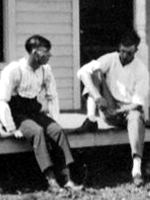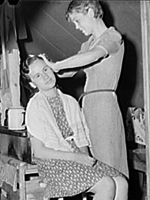
Cox, RobertAbout | Story: Humor and Storytelling | Abstract AboutA founder of the New Mexico Farm and Heritage Museum and his background.
Story: Humor and Storytelling
Jane O'Cain: Did anyone in your family really encourage you in your interest in history and the history of the region and the family history and the history of the ranch? Rob Cox: No, nobody encouraged it particularly. My dad never even got very interested in history or genealogy. He never got interested in that until in his later years after he'd quit working and I used to heckle him about it. I said, "Dad, you're going to find out more than you want to know one of these days." And he said, "Well, I've run into a little of that already." No, they spent all their time working. JO: Well, was there a great storyteller in your family? RC: Well, in the old days, all those old guys were pretty good storytellers, but that was their way of entertainment. We didn't have any musicians in our family, and in, in the evenings you'd sit around and we didn't even have radios, so they'd just talk and visit and tell things that had happened and recount what little historical things that they knew and that they had heard about. JO: Would you say that your father and mother were influential in encouraging you to be interested in agriculture and ranching? RC: I would think so. They really didn't try to talk us into this. In fact, my mother said, there were three of us boys. She said, "I wish at least one of my sons would be something besides a rancher. I'd like for them to have a job or a business that they didn't have to depend on the weather." And it didn't happen. Oh, [my wife] Murn can tell you I tell great long stories. JO: (Laughing.) So there was some of that way of trying to tell them about the past. And I think that's an important connection that people have to the older generation. RC: My granddad in particular had a great sense of humor. My dad was a little more serious. But my mother, she was pretty good. And I'm always heckling people, and I have a pretty good sense of humor. My mother had a way of always putting me in my place so if I start telling too many wild yarns or making fun of people, she'd put me in my place, in a cute way. JO: You almost need a sense of humor to survive in this world, don't you? RC: Oh, absolutely. Now, this business, you don't get in the ranching business for the monetary return. You know the only reason we're out here, 'cause this is what we like to do. I tell everybody we're too dang dumb to do anything else. Abstract
Tape 1, Side A
Mr. Robert Coffelt Cox's mother was born in Deming and was raised on a ranch near Kingston. His father owned the San Augustine Ranch. His parents married in 1917. At the time of the interview, Mr. Cox is the Chairman of the Museum Board and has been a little less than a year; the term is limited to a year until the governor appoints a new board. He went to college at Texas A&M and majored in animal husbandry. He joined the military in 1941. Following his military service, he purchased a ranch in Sierra County that he owned and operated for thirty years. Later, he took over the San Augustine Ranch from his father. He has been active in the state Cattle Grower's Association for some time. He also belongs to another small group, the Southwest Grazing Association, which also is a support group for ranchers. Being active in the Museum is another way in which Cox hopes to create an educational place for the young to learn about the rural heritage, especially now that so few (two or three percent) people feed and clothe so many. Cox recalls the tremendous labor of the immigrants crossing over the Rocky Mountains and the to get here, then breaking the sod, clearing the land, and the difficulties of getting water. He mentions that many times rocks were used for fences, due to the lack of other resources.
Tape 1, Side B
He first heard of the idea of a farm and ranch museum in 1987 through Gerald Thomas, then President of New Mexico State University (hereafter NMSU) who wanted the museum to be, in part, a repository for regional artifacts. About 150 people attended the first meeting. From that meeting the nucleus of the Foundation Board was formed. Bill Stephens was named the first Executive Secretary of the Farm and Ranch Heritage Institute, as it was then called. (Since Edson Way became the director many Museum concepts have been energetically developed.) Bill McIlhaney was the first president of the Foundation Board and appointed the various committees. Cox's job was to fund raise in all of southwestern New Mexico. Before the state legislature passed the legislation founding the Museum, it was difficult working through the government, the legislature. "It's never a good time to raise money," he says. And, because no building had been erected, corporations were loath to give money. Cox feels that a lot of money was wasted on consultants that could have been better spent, but state law required that certain surveys, etc. be completed. Matching funds also had to be raised to meet terms established by the legislature. An architectural study of some of the historic farms and ranches in New Mexico was done.
Tape 2, Side A
The consultant says that Dr. Stephens worked to get the Museum located in Las Cruces. NMSU didn't want it on their land because they realized that it was not going to be a University project. "We had to borrow some money to operate our Foundation Board, and individual's had to sign notes . . . Governor Carruthers then put it under the Office of Cultural Affairs. I . . . learned to have a lot of respect for Helmuth Naumer. He knew his business. He said, 'You'll do well if you have it [the Museum] in ten years.'" Another problem was encountered in hiring the architect for the Museum "in the bid process and subsequent threats of lawsuits." Felicia Thal, "through her efforts . . . got this thing resolved." When Governor Johnson was elected he also supported the Museum concept, and the completion of the Museum building. "Ed Way came and got a thirty year lease on the land for a dollar a year on Dripping Springs Road." Cox feels that the Foundation and the Museum Boards get along well. Reference is made to the struggle over the kind of logo the Museum should have concerning the two interests represented, "farming" and "ranching." Cox speaks of strong Foundation people and mentions Barbara Funkhouser, Gerald Thomas for initiating the idea, Lana Dickson, and Bill Stephens. Cox is pleased with the outcome of their plans for the Museum; now what remains is "ironing out the wrinkles." "There will always be a struggle, competition for funds. I would like to see the Museum get the footing where it doesn't need state money, although Naumer says museums never pay their own way." |

